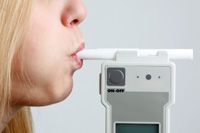Researchers Test Correlation between IBS Symptoms and Methane, Hydrogen Gas Concentrations
Researchers at the Hanyang University College of Medicine set the record straight on the association between IBS symptoms and methane and hydrogen gas produced by intestinal fermentation of lactulose and excreted in the breath during lactulose breath test.

Though studies have shown that patients with irritable bowel syndrome (IBS) more frequently have small intestinal bacterial overgrowth (SIBO) detected noninvasively by a lactulose breath test (LBT), debate still surrounds SIBO as a cause of IBS. And while other literature has advocated for measuring exhaled methane as a diagnostic test for constipation-predominant IBS (IBS-C), another study found significantly less methane-producing bacteria in IBS patients compared to healthy control subjects.
To set the record straight on the association between IBS symptoms and methane and hydrogen gas produced by intestinal fermentation of lactulose and excreted in the breath during LBT, Kang Nyeong Lee, MD, and colleagues from the Department of Internal Medicine at the Hanyang University College of Medicine in Seoul recently published their recent research results on the topic in the June 2013 issue of the Journal of Korean Medical Science.
For their study, the researchers enrolled 68 patients who fulfilled standard Rome III criteria for IBS and 55 healthy control subjects between October 2006 and October 2007. In the IBS group, 35 patients had diarrhea-predominant IBS (IBS-D), 23 patients had IBS-C, and 10 patients had a mix of both (IBS-M).
After an overnight fast, all participants filled out a questionnaire evaluating the severity of their lower gastrointestinal (GI) symptoms — such as abdominal pain, diarrhea, constipation, and bloating — prior to undergoing LBT. The LBT results showed IBS patients had a higher LBT positivity [LBT (+)] for hydrogen than the control subjects, but LBT (+) for methane was no different between the IBS group and the control group, and LBT (+) across the board was about the same among the IBS subgroups. The researchers considered an IBS patient’s LBT results positive when breath hydrogen concentration rose above 20 ppm or breath methane concentration surpassed 10 ppm within 90 minutes.
With the exception of their discovery of a modest correlation between total methane and hydrogen amounts produced during LBT and bloating (r = 0.324, P = 0.039), flatulence (r = 0.314, P = 0.046), and abdominal pain (r = 0.364, P = 0.018) in the LBT (+) patients, the authors wrote that “there were no significant differences in symptom severity scores between the LBT (+) and LBT (-) IBS patients … and LBT (+) IBS patients for methane did not differ from the LBT (-) IBS patients for methane in the symptom severity scores of constipation.”
Therefore, the investigators concluded that the amounts of methane and hydrogen gas produced during LBT were not associated with diarrhea, constipation, and other lower GI symptoms of IBS, so the gases “may not be useful in predicting symptom severity of IBS and do not indicate the subtype of IBS which develop.”